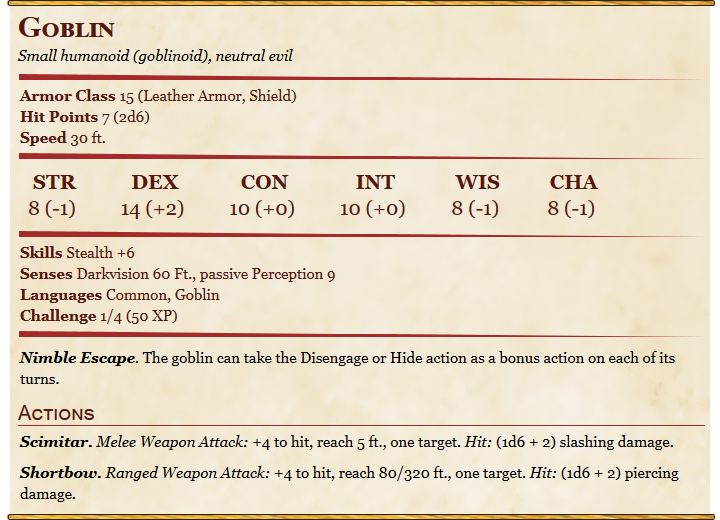15 Sep 2018
Let’s face it, one of the main purposes of Monsters in D&D is to serve as battle fodder for Adventurers. It’s time to explore the bottom section of the Monster stats, and talk Weapons and Combat.
Warning: I have tried my best to make the contents of this series understandable without too much knowledge of the D&D 5e rules. This post goes into more arcane details than the previous ones, because the rules of combat are pretty intricate, and the details matter. I guess that is unavoidable: anything non trivial domain modeling effort will require diving into nitty-gritty details at some point.

From a domain modeling standpoint, this part is a bit messy. We have a sub-section labeled “Actions”, but the items listed there are not actions - a Scimitar or a Shortbow are weapons. To make things even more confusing, right above, we have a section that isn’t even labeled, but contains actions - Nimble Escape allows the Goblin to take special Bonus Actions, Disengage or Hide.
So… what should we make of this?
More...
12 Aug 2018
In our previous episode, we took at stab at modeling Hit Points, which lead us to exploring the representation of dice rolls as expressions. Today, we’ll relax a bit, and finish up the missing parts of the top section of the Monster description:

What are we missing at that point? The creature type (“small humanoid”), Alignment (“neutral evil”), the Armor Class, and Speed. Let’s add that in, and improve our Markdown renderer in the process.
More...
31 Jul 2018
Now that we have a reasonably working Abilities block, let’s take a stab at a slightly more challenging section of the Stat Block, the Hit Points.

Hit Points represent the “life force” of a creature, so to speak. Mechanically, this is how much damage a creature can take until it dies, and is expressed in dice rolls (2d6 for a Goblin), and a default average number, if one doesn’t want to roll the dice (7 for a Goblin). What this means is that, when creating a Goblin, you could either give him 7 hit points, or roll and add 2 6-sided dice, which would result in hit points between 2 and 12.
Things can get a tad more complicated - for instance, Constitution influences hit points. A creature with high CON will get a bonus (more on this later), resulting in expressions likes 4d10+8, which translates to roll 4 10-sided dice, sum them, and add 8 to the result.
Beyond Hit Points, dice rolls play a central role in D&D, and show up everywhere (see for instance the Hit description for the Goblin’s Scimitar and Shortbow, under Actions). We need a reasonably general way to model them.
More...
25 Jul 2018
Time to start creating monsters! We will begin with the Abilities section of the Stat Block.

First, what are Abilities? Every creature is described by 6 Ability Scores, which describe by a number from 1 to 20 (or possibly more) how able the creature is, across 6 dimensions:
- STR (Strength)
- DEX (Dexterity)
- CON (Constitution)
- INT (Intelligence)
- WIS (Wisdom)
- CHA (Charisma)
Ability scores have a dual usage: as raw scores, and as Ability Modifiers, which indicate a bonus or malus for that ability (see the rules for details). As an example, the Goblin has an INT score of 10, which is perfectly average and gives a modifier of 0; his DEX is 14, giving him a +2 bonus, and a CHA of 8, with a malus of -1.
More...
23 Jul 2018
I have been going through a bit of coding demotivation lately. Nothing dramatic, I simply did not feel like writing code, and most of my creative energy has gone into other activities, most notably Dungeons & Dragons (D&D in short).
And then, unexpectedly, I got excited again. Long story short, I take my new Dungeon Master duties seriously, and have been spending quite a bit of time preparing the campaign for my Adventurers. For those of you not familiar with D&D, the game works along these lines: a group of Adventures (the players) are immersed in a fictional universe (think Lord of the Rings), where they can decide to do whatever they please. One person plays the role of the Dungeon Master (or DM), responsible for the universe around them, constructing an (hopefully) engaging storyline, narrating events, reacting to the Adventurers’ choices and resolving their outcomes based on a fairly dense rule set.
So what does this have to do with programming?
More...

